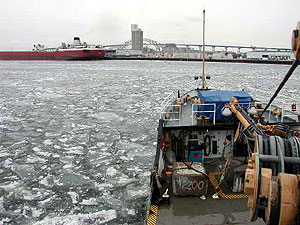|
Audio
Photos
Your Voice
|
Coast Guard cutter breaks the ice in Duluth
March 24, 2003
 |
| The Coast Guard cutter Sundew slices through ice to open a shipping lane in the Duluth harbor. (MPR Photo/Chris Julin) |
Duluth, Minn. — The ice on the Duluth harbor is still more than thick enough to hold the biggest pick-up truck, and it's thick enough to keep cargo ships locked in place. The ships spent the winter here.
 | |||
Now the Coast Guard cutter Sundew is carving a path through the ice so the ships can leave.
The Sundew churns its way across the harbor through ice that's two feet thick. The ship's bow tips slabs on edge. Each slab looks like the floor of a single-car garage tilted into the air. The Sundew will cut a swath several miles long, then turn around and come back along the same path. With each pass, the shipping lane gets a little bit wider.
Beverly Havlik is the commanding officer on the Sundew. She's out on the deck in rain gear and a wool cap, watching the ice.
"We're taking out just little shaved bits of it at a time to make the ice chunks smaller," she says. "It's like sawing a log, just shaving off a bit of it at a time."
 | |||
The Sundew was not built as an icebreaker. Its usual duty is tending buoys. The ship places and maintains about 200 navigational buoys all around Lake Superior. But a couple decades ago, the Sundew got some extra steel added to its hull, and a new, bigger engine. Since then it's done double duty as an icebreaker.
Commander Beverly Havlik says the Sundew slices through thin ice like a butter knife, but in thicker ice, like this stuff, the hull actually rides up on top of the ice and pushes down through it.
That's why there are three mini-van-sized chunks of concrete on the ship's deck. Each one weighs 12,000 pounds.
"It keeps the weight down forward more," Havlik says.
It's kind of like putting sand bags in the back of a pickup truck in the winter.
 | |||
"It's a similar sort of principle," Havlik says. "It gives you the bite you need."
Icebreaking is serious business. It gets the ships moving weeks before the ice melts.
But beyond that, Beverly Havlik says it's really fun.
"This is awesome," she says with a laugh. "It's the only job that I'd ever had where they pay us to come out and break something."
The Sundew is 180 feet long -- the length of 10 canoes lined up end to end. It has about 50 crew members. One of the junior crew members is usually at the wheel. He's the "helmsman."
 | |||
But the real "driver" is called the conning officer, who's standing 20 feet away, out on the deck through an open door. The conning officer adjusts the ship's speed, and decides where and when to turn the ship, but he doesn't have a steering wheel out there on the deck. He calls out a steady stream of steering commands to the helmsman, who's standing inside at the wheel.
"Helmsman, right five degrees rudder!" hollers the conning officer - a young man out on the deck in a big rabbit fur hat.
"Right five degrees rudder, aye!" calls back a younger man inside the pilot house. He spins the ship's steering wheel and hollers, "My rudder's right five degrees!"
"Helmsman, steady as goes!"
"Steady as she goes, aye!"
 | |||
This throat-straining dialogue continues for hours as the Sundew crunches through the ice.
Ensign Jason Frank is the conning officer in the rabbit fur hat. He says he likes being on deck, but it can be an uncomfortable job.
"We actually have face masks and goggles for when it gets really cold," he says. "It's gets so cold out here sometimes it feels like your eyes are going to freeze out, or something."
Frank is half way through his two-year stint on the Sundew. Then he'll be stationed somewhere else, and the Sundew will be removed from service. The ship was built in Duluth in 1944, and it's retiring next year.
 | |||
Jason Frank wanted to work on the Sundew because aren't many ships like this still in service. On newer vessels, the officer driving the ship stands inside. And the Sundew's big, brass steering wheel is more common in the movies that it is on real ships these days.
"Most the new ships have just a little joystick," says Frank. "It's very similar to like a joystick you'd have maybe when you're playing a computer game or something. All you have to do is turn that joystick and the computer tells the rudder what to do."
That's not how the Sundew works.
"We're actually maneuvering the throttles, we're actually driving," Frank says."With the new ship, basically it has an autopilot."
The Sundew will be chopping away at the ice in the Duluth harbor until the weather warms up, and a good southwest wind comes along to push the ice out of the harbor into Lake Superior.
|
News Headlines
|
Related Subjects
|
